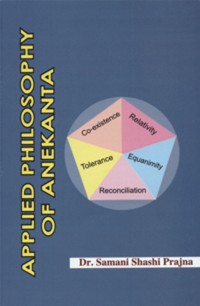The Jaina metaphysics is a realistic and relativistic pluralism. It is called anekāntavāda or the doctrine of the manyness of Reality.[1] Matter {pudgala) and spirit (jīva) are regarded as separate and independent Realities. There are innumerable material atoms and innumerable individual souls which are all separately and independently real. And each has got an infinite number of characteristics of its own[2]. A thing possesses innumerable positive and negative characters. It is not possible for us, ordinary people, to know all the qualities of a thing. We can know only some qualities of some things. To know all the aspects of a thing is to become omniscient. Therefore the Jainas say that he who knows all the qualities of one thing, knows all the qualities of all things, and he who knows all the qualities of all things, knows all the qualities of one thing[3]. Human knowledge is necessarily relative and limited and so are all our judgments. Mahāvīra propounded that our conduct and behaviour are conditioned by our metaphysical speculation. The incentive for social change emerges from a 3 Ācārāñga Sūtra. Ed. Yuvācārya Mishrimalji 'Madhukar'. With original Text, Hindi version, Notes, Annotation and Appendices. Beawar: Shri Āgam Prakashan Samiti, 1998, 3.74. deep and sound metaphysical theory, which requires proper
application of logic to experience. Samantabhadra, (2n century CE) an ardent follower of Mahāvīra, argues that the conceptions of bondage and liberation, punya and papa (merits and demerits), heaven and hell, pleasure and pain and the like, lose all their relevance and significance if we exclusively recognize either permanence or momentariness as constituting the nature of substance.[4] The affirmation that the momentary disintegration of all things renders impossible such things as, financial transactions, memory, and the common-place relations of the husband and the wife, the teacher and the taught, and also indicates the subservience of ethical problems to the nature of being.
Mahāvīra differs from all absolutists in their approach to unfold the inner nature of reality. He weaves the fabric and structure of reality on the authority of indubitable experience and is not swayed in the least by the fascinations of a priori logic. Mahāvīra evaluates what is given in experience, and consequently advocates change to be as much ontologically real as permanence. Both are separable, but only in logical thought. Being implies becoming and vice versa. Inconsistent as it may appear at the inception, there is no doubt that experience enforces it and logic confirms it. Mahāvīra adhered to the common experience and found no contradiction between permanence and change, both being free from all absolutism.
A thing has many characters and it exists independently. It is called substance (dravya). It persists in and through all attributes and modes. Substance is defined by Umāsvāti as guṇaparyāyavad dravyaṁ, that which possesses qualities and modes[5]. Out of these innumerable qualities of a substance, some are permanent and essential, while others are changing and accidental. The former are called attributes (guna) and the latter modes (paryāya). Substance and attributes are inseparable because the latter are the permanent essence of the substance and cannot remain without it. Modes or modifications are changing and accidental. Jainism here becomes a 'theological means, between Brahmanism and Early Buddhism'. Brahmanism emphasizes the one, the permanent, the real; Early Buddhism emphasizes the many, the changing, the unreal; Jainism points out that both are the two sides of the same thing. Reality, therefore, is also defined as that which possesses the three characteristics of origination, destruction and permanence.[6] Substance has its unchanging essence and therefore is permanent. But it also has its changing modes and therefore is subject to origination and decay. To mistake any one-sided and partial view as the whole truth is to commit the fallacy of ekāntavāda. As Jainism takes into account all these partial views from respective perspectives, it is called anekāntavāda. Anekānta does not imply that the knowledge of one, who knows partial truth, is an aikāntika and the knowledge of one who knows, the whole truth is anekāntika. The basis of anekānta is the triplicate nature (i.e. origination, cessation and permanence) of substance and not limited or unlimited to knowledge (i.e. śrutajñāna and kevaljñāna).
In this chapter effort is made to explain the concept of sat from the Jain perspective in detail with sufficient examples quoted by various ācārya-s of different time. A critical analysis of Reality can be seen throughout and it is depicted, how change is part and parcel of society based on this concept of trinity of Reality.
Jain philosophy has an important place in the domain of Indian philosophies. The concept of Reality occupies the foremost place in Jain metaphysics. It is metaphysical nature of Reality which acts as a foundational stone in explaining the basic concepts of Jain ethics, Jain theory of karma, Jain epistemology and Jain theory of anekānta. The essence of threefold nature of Reality, i.e., utpāda, vyaya and dhrauvya, is discussed in brief, but its contribution to the world of philosophy and to the world of affairs is taken into consideration to deal it elaborately. In my view, the concept of reality is very peculiar and unique in Jain philosophy. Now, let us see what actually Jain Reality is.
Here the term, 'Reality', refers to the Jaina concept of entities, objects, so a capital R is used throughout.
Ācārāñga Sūtra. Ed. Yuvācārya Mishrimalji 'Madhukar'. With original Text, Hindi version, Notes, Annotation and Appendices. Beawar: Shri Āgam Prakashan Samiti, 1998, 3.74.
 Dr. Samani Shashi Pragya
Dr. Samani Shashi Pragya

